Paclitaxel nanoparticle awakens immune system to fight against cancer†
Abstract
A high concentration of paclitaxel (PTX) is used as an anti-tumor chemotherapy but is toxic to immune cells. At lower concentrations, PTX was found able to stimulate the anti-tumor potentials of immune cells. Thus, decreasing the cytotoxicity of PTX at high concentration while maintaining its anti-tumor stimulation to immune cells remains challenging. Herein, by employing a click condensation reaction, we rationally designed a PTX derivative, Cys(StBu)-Arg-Arg-Arg-Lys(PTX)-CBT (1), for the facile preparation of its nanoparticle 1-NP. In vitro assays indicated that, at high PTX concentrations, 1-NP showed significantly lower cytotoxicity to macrophages than did PTX, and could be efficiently phagocytosed by macrophages and consequently polarize the cells into an anti-tumor state in a dose-dependent manner. In vivo experiments further confirmed that 1-NP had a higher anti-tumor efficacy than did free PTX but lower cytotoxicity to immune cells in both immune organs and tumor sites. Our results suggest that, by using different doses of 1-NP, patients can precisely regulate the activation of the immune system for an effective anti-tumor and balanced autoimmune responses. We also envision that our strategy could lead to a combined use of immunotherapy and chemotherapy for a more efficient anti-tumor treatment in the future.



 Please wait while we load your content...
Please wait while we load your content...